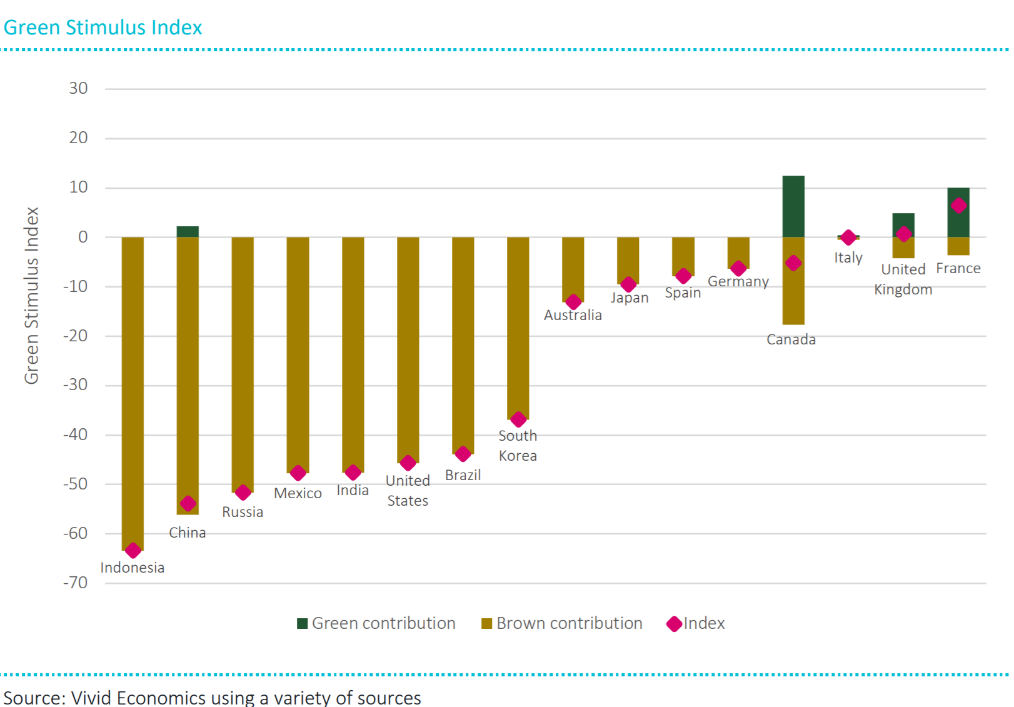Blog

Institutions show agility and acceptance of change
COVID-19 has caused human suffering on a scale unprecedented in recent times – both because of its immediate public health ramifications, and the simultaneous economic devastation that has left millions jobless. It has already triggered rapid responses in governments and economies around the world, making this a rare moment of institutional plasticity that brings with it an occasion to enact long-lasting and meaningful change. It is unfortunate that policymakers have overlooked this opportunity to adopt a ‘green growth’ model, with India’s INR 20 lakh crore (~$307 billion) stimulus package serving only to strengthen already-entrenched fossil fuel industries in an attempt to kick-start growth.
India’s stimulus package looks to re-start the economy
Dampened by a “longer period of lockdown and slower recovery than anticipated”, India’s economy is predicted to contract by 3-5% this fiscal year. The proposed stimulus package looks to mitigate the associated fallout and is divided into five distinct tranches – namely Business & MSMEs; Poor, including migrants and farmers; Agriculture; New horizons of growth; and Government reforms. In line with most global practice, bolstering public infrastructure, and domestic industry seem to be key priority areas though there is an added emphasis on support for farmers and migrant workers as well. A broad summary of the package and its various features can be found here.
It is clear that India’s stimulus package prioritises economic growth – as it should. However, it is founded on the fallacious assumption that achieving climate and economic goals are two competing priorities. In fact, a recent analysis by Vivid Economics shows that India’s stimulus package performs abysmally in comparison to others. The few environmental co-benefits seem incidental at best, and thus, I try to suggest a few recommendations on how this “once in a lifetime opportunity” can be leveraged to facilitate a greener recovery pathway for India.

India’s poor performance on the ‘Green Stimulus Index’. Source: Vivid Economics Analysis
Adoption of clean technology by MSMEs can make a considerable impact
In a bid to maintain food security as well as the livelihoods of millions of farmers, the stimulus package has set aside a considerable sum of money for improving agriculture supply chains. Doing so requires the creation of storage facilities, cold-supply chains, formalisation of micro food enterprises, and upgraded animal husbandry infrastructure. The associated demand for building materials and energy can be met in a resource-efficient manner if financial incentives for adopting more sustainable technologies and options are provided. Policymakers may refer to a detailed list of recommendations published by WWF India and cKinetics aimed at creating a conducive environment for the adoption of energy efficient technologies and processes by MSMEs. Adding an economic argument for energy-efficiency, an article by the IEA suggests increased savings and jobs coupled with lower long-run emissions makes it an ideal component of a ‘green recovery’. Similar incentives for MSMEs to improve their environmental performance through energy efficiency and/or captive clean energy sources should also be established.
Electricity sector reforms show promise, but coal is still king
INR 90,000 Crore (~ $12 billion) has been earmarked for a liquidity injection for discoms (distribution companies) to allow for timely payments to generation companies. A large portion of these are renewable energy generators, which technically enjoy a ‘must-run’ status that affords them priority. Unfortunately, there is no major priority placed upon clean energies under this scheme, and even payments made to generators seem to be done haphazardly. For it to be truly a ‘green recovery’, this stimulus package would ideally have not only prioritised benefits for renewable energy producers, but would also have aimed at the retirement of polluting technologies such as coal (which on average produces nearly 70% of India’s electricity). The latter seems highly unlikely given the current government’s push for privatisation and expansion of domestic coal (and mineral) mining, which only deepens our economic dependence on high-emission fuels.
The good news is that the package does come with performance-based incentives for discoms, though this has been in the works under the guise of UDAY 2.0 for a while now anyway. It is also important to note that the incentives are linked to purely operational benchmarks – which do reduce leakages but do not have the targeted impact that a set of environmental performance benchmarks could potentially catalyse.
Tariff policy reform is another subject up for reassessment in the stimulus, and it is heartening to see that the government intends to reduce the cross subsidisation of agricultural electricity consumers by their industrial counterparts. Given India’s goals of increasing self-reliance and domestic manufacturing capabilities, a reduction in commercial and industrial tariffs can attract investment and prevent capital flight. MSME (Micro, Small, and Medium Enterprise) players will also see benefit in this, and it paves the path for an eventual transition towards financially sustainable business models in the power sector. It should be noted that a reduction in cross subsidisation may lead to agricultural consumers facing the growing burden of increased energy expenses. Decentralised solar energy is an appropriate solution here that could also address the energy demands of a burgeoning agri-supply chain (discussed earlier); such clean energy solutions should be offered at discounted rates to these consumers as a sustainable alternative.
Welcoming-in the Work From Home era
On the urban front, India and the world’s shift towards the work-from-home economy has reduced energy usage for transportation considerably. The IEA suggests that roughly 13% of India’s workforce can potentially continue working from home (‘telework’) during the new post-lockdown status quo – a scenario that should be actively encouraged and pursued by the government. Currently about 13% of carbon emissions in India come from the transport sector, though that is slated to increase dramatically towards the second half of the century. By bolstering network infrastructure, subsidising residential energy efficiency technologies, and ensuring clean and reliable electricity provision, a new teleworking economy could maintain economic growth without the usual transport-linked emissions and congestion.
Migration issues are troubling but can be handled responsibly
Finally, a slew of reverse-migration can see much of India’s estimated 65 million inter-state migrants move back to their villages across the country. Anecdotal evidence seems to suggest that many of these migrants are disillusioned about the promise of a better life in the cities and may choose to stay back in their hometowns, even if the state borders are re-opened. Looking at the silver lining, this offers a unique opportunity to rethink the traditional urban-centric growth paradigm and plan for a more decentralised approach. Town planning should be prioritised with an emphasis on clean energy, energy efficiency, and sustainable transport models.
As a stop-gap measure, incentives are currently on offer for the construction of affordable housing units for these migrant workers. Building materials such as steel, cement, and bricks are typically extremely carbon intensive to produce, and therefore Incorporating low emission alternatives (such as fly-ash bricks) will have a significant impact on the environment. In general, the government may consider ensuring that all new housing projects follow green building guidelines as forwarded by institutions such as the Indian Green Building Council. Investments in R&D for creation of low-carbon materials and technologies can also stimulate economic activity and provide thousands of jobs, all while providing climate-resilient solutions.
Climate change has broad implications and efforts to mitigate it should be redoubled
Countries like India and China that have historically struggled with issues surrounding air pollution are enjoying brief respite as emissions dropped dramatically, affording citizens a rare glimpse of blue skies, typically shrouded in blankets of smog. The relief is temporary though, as the goal of climate-friendly development relies on systemic decarbonisation – not just short-lived emissions dips caused under debilitating circumstances such as that of today’s. Climate change has been gaining attention due to its links with recently experienced phenomena including the effects of COVID-19, cyclone Amphan, air pollution, and even locust infestations in many parts of the country. With burgeoning public support for environmentally friendly economic policies, it is time to strike while the proverbial iron is still hot and leverage India’s economic stimulus to enable climate-friendly development in the long run.
***
Raghav Anand works as a Senior Program Manager for Clean Energy Finance at Shakti Sustainable Energy Foundation.
